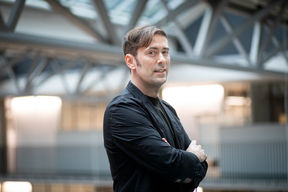Petter Holme: Temporal networks help to understand the spreading dynamics

What do you research and why?
My research concerns networks in general – power grids, social and ecological networks, bus transportation, and many others. I approach my research using mathematical theories and frameworks, as well as computer modelling. Concrete examples of these networks studied include Internet dating, the Frozen movie, and the Covid epidemic.
Interdisciplinary research leads me to work with experts from many disciplines, including sociologists and biologists. Sometimes it's frustrating, sometimes rewarding to learn a new language.
The world and the challenges we face are very complex. Climate change, for example, is ultimately also a network problem, and I would like to explore this in the future. I am also interested in the interface between digital humanities and network science.
How did you become a researcher?
In high school, I was interested in physics, abstract thinking and problem solving. I also read popular science books about the quantum revolution. I was a competitive person and wanted to challenge myself.
At university, I also started studying Chinese and Chinese literature, both at Stockholm University and in China. However, I could not go on to a doctorate because the field is largely underfunded. I had to choose another field. I ended up doing a Master's degree in Engineering Physics.
I like interfaces between different disciplines and Asia interests me a lot. I feel like my second home is there; I jokingly call myself Scandinasian. My first full professorship was in Korea and then Tokyo, and I still work with people in Asia.
What is the most important high point of your career?
I hope it's still to come. But I am proud of my collaboration with Professor Jari Saramäki. We met at a conference and found that our papers on temporal networks were published almost simultaneously, although the data, the networks and the impact of time were all different. Saramäki's group was studying phone data and call networks, and we were studying the network of sexual contacts related to prostitution to understand sexually transmitted diseases in Brazil.
In temporal networks, time matters, and networks show who is in contact with whom and how fast something spreads. Together with Jari Saramäki, we wrote a research review on temporal networks in 2012, and a book a year later.
What is the most essential characteristic of a researcher?
There are many different personalities in science. I see that as a strength. Curiosity is perhaps the most common answer to this question, and it motivates many researchers. Perhaps I am one of them. But many scientists are also motivated by careers. Research can be done for many reasons.
See the animation: A concrete example of a network: French school kids wear sensors that show who is near whom. Can you spot when they have lunch and when they return back to their classrooms?
Read more news

The semiconductor sector jobs open in research groups
Semi-Summer 2026 programme will provide an opportunity to gain the skills needed in a growing and international semiconductor sector.
New cooperation agreement between the City of Helsinki and Aalto University to strengthen a sustainable, vibrant and knowledgeable city
The main themes of the cooperation are vitality, innovations and entrepreneurship, as well as research cooperation and knowledgeable labour, drawing heavily on the research and education expertise of the university.






